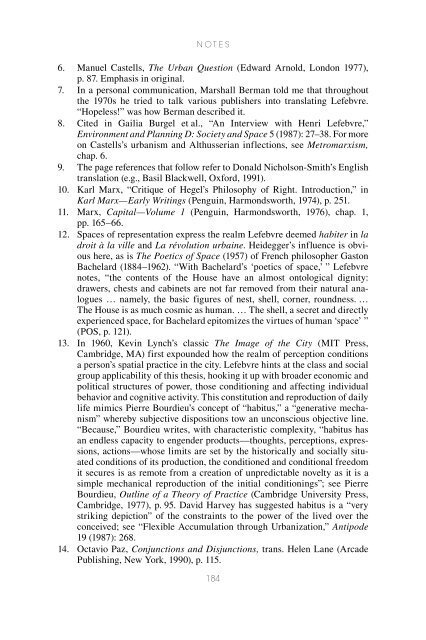Henri Lefebvre: A Critical Introduction - autonomous learning
Henri Lefebvre: A Critical Introduction - autonomous learning
Henri Lefebvre: A Critical Introduction - autonomous learning
You also want an ePaper? Increase the reach of your titles
YUMPU automatically turns print PDFs into web optimized ePapers that Google loves.
n o t e s<br />
6. Manuel Castells, The Urban Question (Edward Arnold, London 1977),<br />
p. 87. Emphasis in original.<br />
7. In a personal communication, Marshall Berman told me that throughout<br />
the 1970s he tried to talk various publishers into translating <strong>Lefebvre</strong>.<br />
“Hopeless!” was how Berman described it.<br />
8. Cited in Gailia Burgel et al., “An Interview with <strong>Henri</strong> <strong>Lefebvre</strong>,”<br />
Environment and Planning D: Society and Space 5 (1987): 27–38. For more<br />
on Castells’s urbanism and Althusserian inflections, see Metromarxism,<br />
chap. 6.<br />
9. The page references that follow refer to Donald Nicholson-Smith’s English<br />
translation (e.g., Basil Blackwell, Oxford, 1991).<br />
10. Karl Marx, “Critique of Hegel’s Philosophy of Right. <strong>Introduction</strong>,” in<br />
Karl Marx—Early Writings (Penguin, Harmondsworth, 1974), p. 251.<br />
11. Marx, Capital—Volume 1 (Penguin, Harmondsworth, 1976), chap. 1,<br />
pp. 165–66.<br />
12. Spaces of representation express the realm <strong>Lefebvre</strong> deemed habiter in la<br />
droit à la ville and La révolution urbaine. Heidegger’s influence is obvious<br />
here, as is The Poetics of Space (1957) of French philosopher Gaston<br />
Bachelard (1884–1962). “With Bachelard’s ‘poetics of space,’ ” <strong>Lefebvre</strong><br />
notes, “the contents of the House have an almost ontological dignity:<br />
drawers, chests and cabinets are not far removed from their natural analogues<br />
… namely, the basic figures of nest, shell, corner, roundness. …<br />
The House is as much cosmic as human. … The shell, a secret and directly<br />
experienced space, for Bachelard epitomizes the virtues of human ‘space’ ”<br />
(POS, p. 121).<br />
13. In 1960, Kevin Lynch’s classic The Image of the City (MIT Press,<br />
Cambridge, MA) first expounded how the realm of perception conditions<br />
a person’s spatial practice in the city. <strong>Lefebvre</strong> hints at the class and social<br />
group applicability of this thesis, hooking it up with broader economic and<br />
political structures of power, those conditioning and affecting individual<br />
behavior and cognitive activity. This constitution and reproduction of daily<br />
life mimics Pierre Bourdieu’s concept of “habitus,” a “generative mechanism”<br />
whereby subjective dispositions tow an unconscious objective line.<br />
“Because,” Bourdieu writes, with characteristic complexity, “habitus has<br />
an endless capacity to engender products—thoughts, perceptions, expressions,<br />
actions—whose limits are set by the historically and socially situated<br />
conditions of its production, the conditioned and conditional freedom<br />
it secures is as remote from a creation of unpredictable novelty as it is a<br />
simple mechanical reproduction of the initial conditionings”; see Pierre<br />
Bourdieu, Outline of a Theory of Practice (Cambridge University Press,<br />
Cambridge, 1977), p. 95. David Harvey has suggested habitus is a “very<br />
striking depiction” of the constraints to the power of the lived over the<br />
conceived; see “Flexible Accumulation through Urbanization,” Antipode<br />
19 (1987): 268.<br />
14. Octavio Paz, Conjunctions and Disjunctions, trans. Helen Lane (Arcade<br />
Publishing, New York, 1990), p. 115.<br />
1 4
















